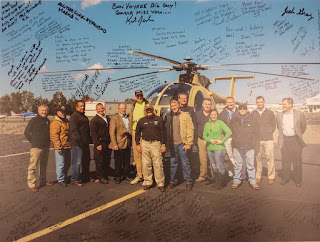During my career as a flight test director at a giant aerospace company, a team of us worked together to develop prototype helicopters. The last few years a small team of us focused on converting a combat proven airframe into an “optionally piloted” asset. The team generally consisted of the project test pilot, lead electrical systems integrator, lead structural and design engineers, flight controls engineers, and a systems safety representative. Besides the project test pilot, several others amongst our team were pilots of some sort from Vietnam era combat veterans or from a civil training environment. The new flight control system was like student pilot that might try to kill the flight instructor, something we could easily imagine.
When we hatched a new idea for a flight test concept, perhaps to perform and demonstrate some new system integration effort, we developed a test plan then gathered to brainstorm about the risks that might be incurred during the execution of the flight test. In retrospect the risks we identified were driven by our combined imaginations and experience. For every risk we identified, we had to assess both the likelihood a “bad” event might occur, and the severity of the outcome. Likelihood was generally considered as the chance of an occurrence either in terms of flight hours or perhaps during specific maneuvers such as takeoffs and landings where a sudden flight control malfunction might leave the test pilot with precious little time to recover the helicopter before contacting terrain. Severity of the event was judged from “scared us” to “damage the flight test asset” to “somebody gets killed”.
We filled out the risk assessment forms, attached them to the test plan, then circulated the package to various department heads for evaluation and concurrence. Sometimes we got pushback that we had missed a potential risk, sometimes that our estimate of the frequency or severity was off. Catastrophic risks or severe, risks that might occur above a frequency level forced a safety of flight review board, a big expensive meeting that was meant to exploit the collective knowledge and experience of all the available gray hairs.
Occasionally during the execution of a flight test program some event would occur that got our attention – something nobody had ever even imagined. We never hurt or killed anyone, but we did scare ourselves more than once.
Cruising is a bit like that. We think about the risks such as someone going overboard, contacting undersea terrain, being caught out in extreme weather, maybe a sudden fire on board, and we put tools and procedures in place to minimize the chance of anything bad happening and a reaction plan if it all goes wrong. Based upon a history of past claims our insurance provider provides us with a laundry list of risk items that might result in damage or loss of JollyDogs. In that regard, they’ve got more experience than plenty of long-time sailors.
A couple of things have come up recently, things we didn’t anticipate. Recently I was out paddling a SUP and got attacked by a shark. Scratch one SUP and nearly soiled my swim trunks. Swing and a miss. The other is the current shortage of food provisions in French Polynesia. Isabel did a great job of provisioning at Nuku Hiva before we departed there five weeks ago, but eggs and leafy greens don’t last forever. Four days after sailing from Nuku Hiva we arrived at Raroia where self-isolation was just going into effect. Now the frequency of supply ships has reduced by about half, and there are shortages of various staples. How long it may last, nobody knows. We’ve got another month of provisions on board, but meals are getting less interesting and less nutritious.
We failed to identify either of these risks. Our knowledge of shark behavior is poor but increasing rapidly. We’ve never endured a global pandemic. We lacked the experience or imagination to envision what’s now happening.
Kind of like a couple of those flight test events.

No comments:
Post a Comment